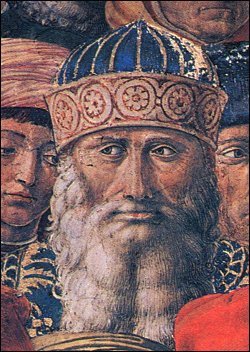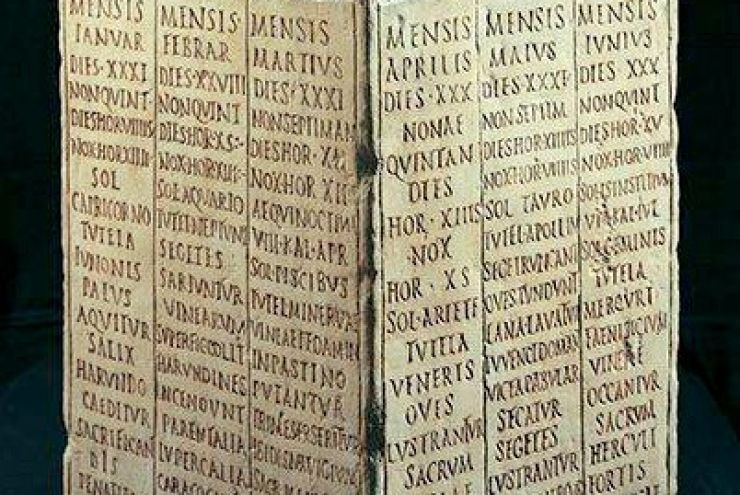
In the fifteenth century we Italians were divided into more than a dozen states, often at war with each other, each with its own history and customs, but the same root. Perhaps thanks to this common root the spirit of our ancient classical tradition re-emerged, giving rise to a cultural movement that forever changed the spirit of the Western world, redeeming it from a millennium of darkness. The Renaissance changed forever the course of our history and that of Europe, which did not understand how from a peninsula without a unitary political plan could manifest the Italian genius with the innovative architectural forms, the elegant frescoes, the amazing inventions and a humanism which resulted in utopia. History did not fall from the sky, but was incarnated by famous people and perhaps fortuitous encounters, perhaps desired by Fate. Among the various figures of importance, there is one that often is missing in our scholastic texts, a philosopher who not only favored the birth of the Italian Neoplatonic movement, but who was the author of the first Renaissance utopia, anticipating several decades the most famous one by Tommaso Moro.
Georgius Gemistus known as Plethon (Γεώργιος Πλήθων Γεμιστός) was born in Constantinople before 1360 and visited Italy as a councilor of the Byzantine delegation on the occasion of the Council of Ferrara and Florence, held in the years 1438-1439, whose main objective was the rapprochement of the church Orthodox and Roman. In those years the philosophy officially accepted by the church of Rome followed the path traced a century and a half earlier by Thomas Aquinas, who had recovered Aristotle as a support for Christian theology. Thomas had not had an easy time for using a pagan philosopher in his theological studies, but in the end, his thought had been accepted by the church and Thomas himself had been canonized saint about a century before the coming of Gemistus. The philosophy of the time, called scholastic, was, therefore, a Christian reinterpretation of Aristotle, while Plato remained on the margins or out of the philosophical discussion.
Gemistus, already the author of various works, including a commentary on the Chaldean Oracles, during his stay in Florence, wrote a “Treatise on the differences between Aristotle and Plato“, clearly in favor of Plato compared to Aristotle, and held various lessons of philosophy obtaining a great consensus from the secular world. After his death in Mistra in Greece in 1452, he published his work “The Laws“, which took up the utopian visions of the “Republic” of Plato, with the presentation of a new polytheist theology and a project for the foundation of a new pagan religion, so to speak “reformed”, thus taking back the ancient idea of emperor Julian, who was aware of the structural and organizational weakness of pagan cults in front of the compact structure of the Galileans. “The Laws” of Gemistus were burned at the stake by one of his Christian opponents, but fortunately some copies were saved. The work of the years spent in Italy left an indelible mark and planted the seed of Renaissance Neoplatonism.
Sigismondo Malatesta, lord of Rimini and Fano, carried the remains of Gemistus, who had died in Greece, and had him buried in his Malatesta Temple in Rimini. Marsilio Ficino in 1490 stated that the lessons of Platonic philosophy of Gemisto had given the impulse that would have opened, twenty years later, the Platonic Academy of Florence through the support of Cosimo de Medici.
From the earliest writings of a political nature, Gemistus affirmed that the prosperity of a state is the consequence of the virtue of its laws. In turn, the laws have a divine order character and therefore must be understood in a metaphysical framework, similar to what Plato explained in the Republic. As for Greek politics, it was Gemistus’s opinion that Byzantium could only survive by rediscovering its own Hellenic roots, reconnecting with its own history and culture. Gemistus invited Byzantium to rediscover the Hellenic national roots, now watered down or forgotten in the crumbling remains of the empire. If on the one hand it can be said that Gemistus was the first Greek nationalist, on the other he had a strong respect for the Roman culture, considered similar to the Hellenic, and listed the king Numa among the great sages of antiquity, proposing a Hellenic-Roman front against barbarism.
Gemistus’s political and ethical works are based on his overall vision of reality, that is, on his metaphysics, which is structured according to the Neoplatonic scheme, but without the magical-theurgical part developed by Porphyry, Giamblico, and Proclus. Because of its simplicity, it can be compared to Plotinus, with an unusual development of the theological part concerning the identification of the deities with the various metaphysical entities. On the other hand, in full harmony with the thought of Plato, Gemistus denounced the fallacy of the mythological and poetic language of tradition and preferred to introduce new schemes at the service of philosophy, even if this meant a departure from traditional mythology.
According to Gemistus, the reality is hierarchically divided into three levels. As expected, on the upper level is the First Principle, the Over-essential One. He is identified with Zeus, the Father-King, the completely transcendent Demiurge. He can be guessed with the Flower of Intellect, the thinnest part of our essence. Zeus is the Creator of the Platonic forms, which in turn are “super-celestial” deities. The forms are divided into two categories. To the first belong the Gods and the Goddesses, who are the creators of eternal bodies, while the second belongs to the Titans, who generate temporary bodies and which are inferior to the first category.
The second order of reality, equivalent to the Nous of Plotinus, is therefore constituted by the super-celestial Gods, which are pure forms. They are the creators of the entities of the sensitive cosmos and as just mentioned they are divided into Gods and Titans. In all divinities one identifies both a masculine principle of form and activity, and a feminine one of matter and passivity. Above all the gods reign Poseidon, the second demiurge, and his wife Hera. Under the divine couple are Apollo, the principle of harmony and unity, and Artemis, division and difference in unity. Following is a triad linked to the concepts of identity, progression and return (monè, proodos, epistrophè) identified respectively with Hephaestus, Dionysius and Athena. Then there are the super-celestial Gods who generate the celestial Gods who dwell in the cosmos: Atlas ruling the stars in general, Tithonus, who is the god of the planets, Dione the goddess of the stars, Hermes who rules the terrestrial demons and Pluto that does not just takes care of the place where souls live after death, but it is also their patron, with a positive function. Below these, there is a group of Goddesses in charge of the creation of the elements: Leto creates ether, heat, and separation, Hecate generates the cold and the connection, Tethys the water and the dissolution, Hestia the dry and condensation. These deities are the legitimate progeny of Zeus, under which there is the group of his illegitimate sons: the Titans.
At the head of the Titans, with a function similar to that of Poseidon, we find Cronus, which however does not act on the raw material, represented by Hera, but on the unstable under the lordship of Aphrodite that ensures the succession of forms between generations. Pan is responsible for the irrational forms given to the animals, Demetra similarly for the shapes given to the plants. Core or Persephone is the patron of our mortal part. She is kidnapped by Pluto under the order of Zeus, offering a singular connection between Tartarus and Olympus, so that a connection is established between soul (Olympic and immortal) and body (titanic and mortal).
At the third level of reality is the perceptible cosmos, shaped by Poseidon in the image of the intelligible world of forms (Nous). The bodies of the perceptible cosmos are therefore called “sons of the sons of Zeus” re-echoing the theology of the Chaldean Oracles. The gods of the third order are called worldly and create mortal objects and beings. These gods are rational and immortal beings, they have infallible souls and incorruptible bodies. Basically, they are the stars and the planets. The matter of bodies is supplied to the eternal entities of Hera, while to the temporary ones of Aphrodite.
The reformed polytheism of Gemistus is based on a sober recitation of hymns and formulas. According to the philosopher, the excess of religiosity is to be condemned as a wicked human attempt to bend the divine will to earthly demands. There are five short daily prayers, one in the morning, three in the afternoon and one in the evening. The style of the formulas is similar to the Proclus hymns or the Emperor Julian’s Sun Prayer. The proposed calendar is inspired by the lunar ones used in classical Greece. The year begins with the first new moon after the winter solstice and the first of each month coincides with the new moon, identifying months of 30 or 29 days. They are thus identified twelve or thirteen months between two winter solstices.
The months, which do not bear Greek names but are numbered sequentially, are divided into four weeks plus an extra day for the months of 29 and two days for the months of 30, so the first day of the new month always coincides with the first day of the First week. The first week is dedicated to Zeus, the second to Poseidon, the third to the gods of the second order, the fourth to the Titans, the Sun and the rest of worldly Gods and to Cronus
The feasts are repeated monthly: the first of the month is dedicated to Zeus, the 2nd to Hera, the 3rd to Poseidon, the 15th to the gods of the second order, the 29th to Pluto, the heroes and the dead, the 30th to introspection and error correction. An annual celebration is also reported on the third day before the end of the year, dedicated to Pluto and the dead.
In the fifteenth century, there was a group of people who discussed polytheism, utopias, national roots and laid the groundwork for a reintroduction of polytheism. We can imagine that in narrow circles forms of philosophical paganism were professed while defending themselves from the mortal arm of the church. This at least is attested not only for the aforementioned Platonic Academy of Florence but also for the Roman Academy of Pomponio Leto, famous among other things for the celebration of the foundation of Rome (Dies Natalis) on 21 April. Despite the ruthless clerical repression, which punished with death every person suspected of polytheism, the flame of tradition continued to shine without ever extinguishing to this day.
Reading the texts of Gemistus today makes us reflect. Before the decadent Byzantium, before the fall of the city by the Turks, he asked the regents to return to national roots, rediscover their identity and reform the state by introducing just laws, looking for an ethic in harmony with the divine. This appeal is still valid for many countries today! The idea of a national polytheism at the base of a new Renaissance is certainly utopian, but the ideas, when they are pure, are not the result of a cold calculation on their success but are the point of attraction of eternal aspirations of men and women who dare to dream. To dream big.
With this article, we end our short journey along the metaphysics of the classical world. Certainly, the Roman Religio does not need metaphysics, but the points of discussion and understanding offered by philosophy have been impressive. We hope that reading has been an opportunity for discovery and thought. May the immortal Gods be propitious to you.
Mario Basile
















